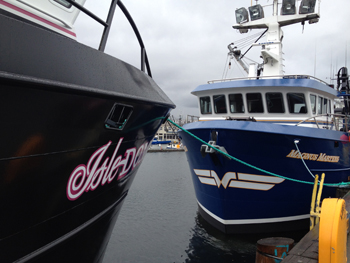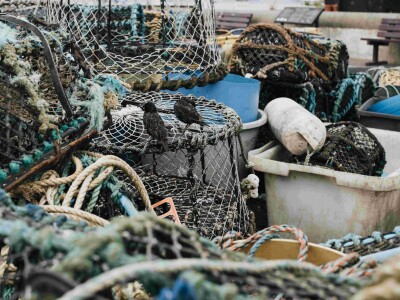OK, you’ve got a boat built in the 1980s or early ’90s. It’s old, the steel has some bad spots and you can’t pack enough product to be competitive. And there are some safety issues.
There are two immediate options, build a new boat or sponson and lengthen what you’ve got. But even after sponsoning and lengthening, much of the boat is still old — tired steel and welds. The same goes for the machinery, piping and electrical systems. Even the sea valves are old. How long has it been since you’ve serviced those? A sea valve lets go and you can be in big trouble.
The 58-foot Isle Dominator and Magnus Martens tied up at Seattle's Fishermen's Terminal shortly after being launched in 2013 from Fred Wahl Marine Construction in Reedsport, Ore. Jessica Hathaway photo.But building new? Hell, who can afford it, now that boats 50 feet and over have to be classed? That could jack the price up by 30 to 40 percent. Another option is to build a boat just under 50 feet, but you don’t want to do that because you fish a lot in heavy weather and you’d feel safer in a bigger boat.
What to do?
Well there may be another option. Currently, both the U.S. House of Representatives and the U.S. Senate have passed bills for the Coast Guard Authorization Act of 2015 that amend the previous Coast Guard Authorization Act that contains the classification ruling.
The Senate bill covers boats from 50 to 190 feet overall length built after Jan. 1, 2016. A registered professional engineer must design the boat to standards equivalent to those prescribed by a classification society.
Since many naval architects already design to ABS standards, it would appear that’s all that’s needed. There’s no mention of classification society approval or active involvement. So classification societies and their accompanying costs are removed from the project.
The same goes for overseeing the building of the boat. A marine surveyor, not someone from a classification society, can be the person in charge.
The bill out of the House of Representatives focuses on boats 50 to 79 feet built after July 1, 2017, and says only that, “the vessel complies with an alternative safety compliance program.” No mention of a classification society.
Now the House and Senate have to work out the differences between the two bills. There’s always the chance that they won’t be able to come to a common agreement. and then classifying boats 50 feet and over will still be in effect. Hopefully that won’t happen. By the end of the year we should know the outcome.







